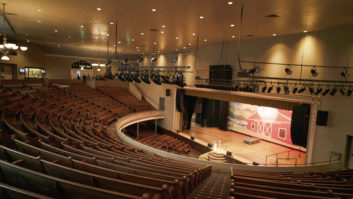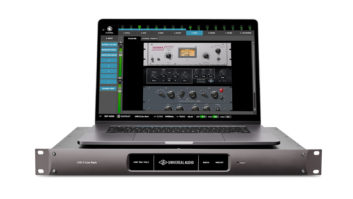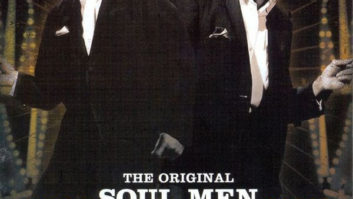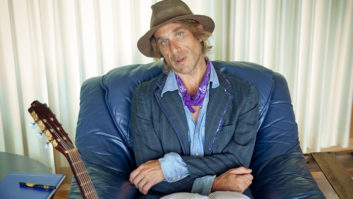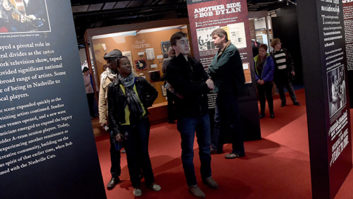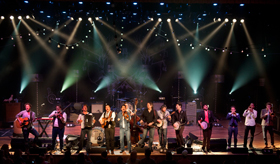
Mumford & Sons, Old Crow Medicine Show and Jerry Douglas doing “Wagon Wheel” during Mumford’s recent sold-out, three-night run at the Ryman.
Photo: Erika Goldring
A few months ago, Nashville’s storied Ryman Auditorium went dark for three weeks while the stage was replaced. The old stage, in place since 1951, was showing wear, and the Ryman staff took advantage of the opportunity to add further structural support to increase the stage’s weight capacity. The new Brazilian teak stage is beautiful and stronger than ever, but now there’s a question on a lot of Nashvillians’ minds: What are they going to do with the old wood?
“I never got so many emails from people,” says the Ryman’s chief engineer, Les Banks. “Everyone requesting pieces of wood, pieces of history.”
For now, the boards walked by legends from Hank to Elvis, from Patsy to Emmylou, are being stored at an undisclosed location. Banks says the wood was removed under strict security, and he speculates that pieces may be sold at some point, “like the seats from Yankee Stadium.” But meanwhile, he says, “I was just told no one’s allowed to remove any wood from the Ryman.”
This sort of thing comes with the territory of working in a place where so much musical history has taken place. Banks has become something of a historian and caretaker, as well as occasional front-of-house mixer, and—for 80 percent of the acts that come in—a technical expert and guide for visiting engineers.
“We’re a museum open to the public,” Banks says of the venue many call the Mother Church of Country Music. “People come by and ask what we do here, and I say, ‘We do rock ’n’ roll, country, weddings and sometimes funerals.’ We’ve had open-casket funerals here for Chet Atkins, Bill Monroe and Eddie Arnold, and we had amazing memorial tributes to Johnny Cash and Tammy Wynette.”
Banks, a 30-year concert sound man, has been the Ryman’s full-time audio engineer since he came off the road in 2000, but he can tell tales about the Ryman’s Opry days as though he’d been there. He will talk about how before the proscenium was added in ‘94, the balcony seats and pews ran all the way to the upstage wall, so in the days before the Opry moved to Gaylord Opryland, “You could hand your autograph book down to Hank Williams before he went onstage, and he’d sign it and hand it right back up to you.” Or he’ll tell a joke—doing a pretty good Little Jimmy Dickens impression—that he says is one of the same jokes the 91-year-old Opry veteran has been telling for decades.
“I absolutely love this place, and I’m proud of it,” Banks says. “We have respect for history; we are history.”
One of the most gratifying aspects of Banks’ job is to help touring engineers manage the challenging acoustics of the 2,362-seat auditorium. “The seating is all original hardwood pews [dating back to the 1890s],” he points out. “There are so many reflective surfaces, and the biggest challenge is the absolutely phenomenal difference between the empty Ryman at soundcheck and a full house that night. It’s night-and-day different; to this day I get freaked out by how loud everything is when it’s empty.”

Chief engineer Les Banks mixes from the balcony of the Ryman.
Photo: Steve Lowry/Ryman Archives
Lesson One in coaxing a nice mix from the Ryman, Banks says, is to turn down the volume: “People will ask me, ‘What’s your dB limit?’ And I answer, ‘Common sense.’ Just take a deep breath and be sensitive to the room. And while they’re upstairs [at the mix position], I’ll take the wireless [Dolby] Lake tablet and walk downstairs. I’m their assistant for the day, so they don’t have to run around.”
Most productions that visit the Ryman bring in their own gear and simply tie into house stacks and racks. The venue is equipped with a Yamaha PM5D board at front-of-house and a JBL VerTec P.A. system. The visitor’s console and house console are routed to a BSS Audio Soundweb London Architect matrix, which distributes signal to all zones; speakers are managed by the Lake system. Stage monitors are recently acquired L-Acoustics 115XTIQ wedges. The venue also keeps a large supply of mics from Shure and others.
Though much of the Ryman’s gear doesn’t see action daily, it’s all very much needed during the holidays, when a popular Christmas program is put on at the Grand Ole Opry, displacing regular live shows/broadcasts. For those three months every year, the Opry comes back to the Ryman, as it did, unscheduled, when the Cumberland River overflowed its banks in May 2010.
“The river got as far as 3rd Avenue, and we’re between 4th and 5th,” says Banks. “So we got very lucky. But water in the Opry House got to be four feet high, and they were underwater for two weeks.” Audio equipment, archived performance tapes and loads of other memorabilia were damaged.
“But as long as you can breathe, life goes on, and the show went on,” says Banks. “I’ve got to give credit to my Opry colleagues, the audio and technical folks over there. The Opry radio show started in 1925 and in 85 or 86 years, they have never missed a live radio broadcast. The flood was on a Sunday, and the next Opry was on a Tuesday. In 48 hours, the Opry had become a road show, playing at different venues around town. We hosted 48 shows for them during the reconstruction, and so many people came to our assistance. SIR provided all the backline we needed. Shure microphones replaced all the mics needed by the show.”
Other venues that hosted flood-displaced Opry shows included David Lipscomb University, Two Rivers Baptist Church, Nashville’s Municipal Auditorium, and the War Memorial Auditorium, which was actually home to the Opry from ’39 to ’43, before the program moved to the Ryman. But the Ryman was the logical choice for most performances—not just because of its historical relationship to the program, but because the venue has an in-house recording/broadcast studio that’s Opry-ready.
“We have ISDN and T1 lines directly to the radio station,” Banks points out. “It’s a fully functional studio with a Harrison Trion console, 120 tracks of Nuendo, Phantom Focus monitors, and we do live recording projects. We recorded Alan Jackson’s gospel record [Precious Memories] here.”
Even when the Opry is operating at full power, the Ryman hosts 200-plus shows a year. Recent visitors include Mumford & Sons (three sold-out shows), Snow Patrol, Merle Haggard, and the Tedeschi Trucks Band.
“The Ryman’s not an easy room to mix,” Banks says, “but even the most hardcore road crews come in and get mellowed out because they’re honored to be here. It makes people happy, and when you look around and see 2,000-plus people smiling, you know everyone feels it. Some of our ushers are 80 years old, and even if we have a loud rock band in here, they’ll say, ‘Oh, Les, that was a good show!’ When that happens, you know that everyone felt it. Everyone went along on the same ride, and that’s why we do it.”
